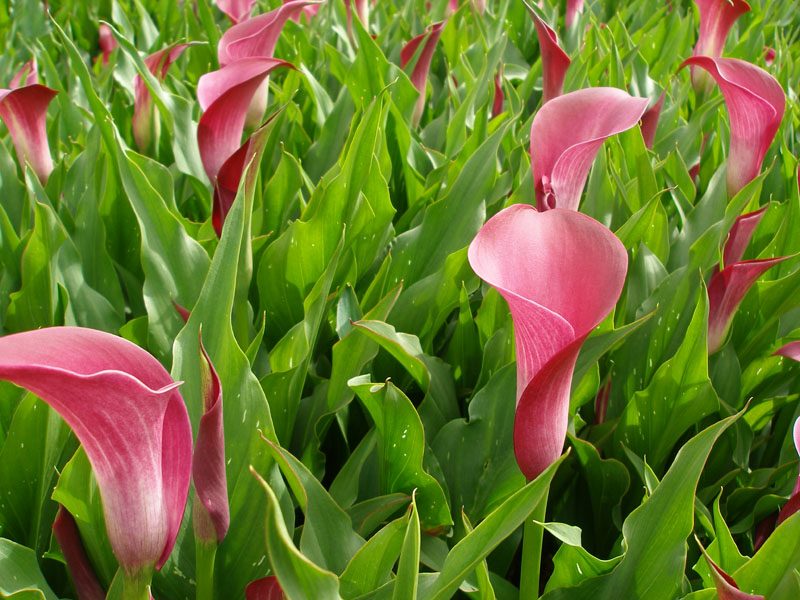If you’re looking for summer blooming flowers and a chance to fill a vase with a bouquet of cut flowers, you can’t beat calla lilies. They’re a nice addition to any summer garden. Calla lilies have a unique trumpet-shape pointing upwards as if they’re playing music for God. They come in a wide array of colors and even the leaves are interesting with their silvery splashes of color.
Calla lilies (Zantedeschia) aren’t a bulb, though the underground rhizomes can look like one. Nevertheless, they can be planted like a bulb. I have fond memories of working in a greenhouse with a wheelbarrow full of calla rhizomes harvested by my students in early fall. They would start sorting them on the benches, keeping the biggest and firmest rhizomes. After sorting and drying them in the well ventilated greenhouse, we would find a cool place to store them over the winter, as they won’t survive in the soil where the ground freezes.
When to plant:
Although calla lilies are known as ‘spring bulbs,’ in warmer climates or (USDA zones 8-10), calla lilies thrive outdoors year-round. Click on map (right) to find your hardiness zone by zip code). In more temperate and cooler zones, they can be planted in the spring when temperatures are consistently above 55º F. Make sure that there is no danger of frost or of temperatures dropping below 55º in the first 12 weeks after planting.

Where to plant:
Plant in full sun, especially in the northern states where the summers are cooler. Callas can be grown in light shade in the southern locations of the country. They like some late afternoon shade, particularly in areas that experience hot-summers.
Planting depth:
Callas grow best in a moist soil that includes some organic matter and need to be kept well-watered. Plant them no deeper than 4″ inches.The tips of the corm should be pointed upward and have approximately 1″ – 2″ of soil above them.
Spacing:
Plant the bulbs 12 to 18 inches apart.
How to plant calla lily bulbs:
Let’s face it, most bulb planting methods have us spending a lot of time bending over or on our knees. The ProPlugger 5-IN-1 Planting Tool allows you to do most of the hard work of digging your bulb planting holes from a standing position.
To pull plugs, slide the 2″ or 4″ metal depth ring onto the bottom of the main tube to set the desired depth of the planting hole. Or to dig a 6″ deep hole, no depth ring is needed.
(Step, Twist and Pour) Step down on the foot pegs until the depth ring bottoms out against the ground. Give the 5-IN-1 a slight twist to break the soil plug free and pull straight up on the handlebars. To empty the plugs, simply turn the plugger upside down and pour the plugs out of the top of the tube.
The soil gets stored inside the tool as you work, enabling you to dig over a dozen planting holes, one right after another. Place the bulb in the planting hole, pointed tip facing upward. Fill in the hole with the soil you removed with the 5-IN-1. Firm the soil over the bulb with your foot.
Feeding:
When the leaf tips begin to poke out of the ground, apply a 5-10-10 fertilizer. About the time of flowering, top dress with a 0-0-10 or 0-0-50 fertilizer. Mulching around the plants with aged compost or well rotted manure will achieve the same effect as a light feeding of fertilizer.
Disease and pests problems:
Because calla lilies are typically planted in warmer, more humid areas of the country, fungus problems, such as crown rot and pythium rot, along with some viruses, including spotted wilt, can be a problem. Good air circulation is a preventive measure for virus and fungus problems. Fungus problems can also be prevented by planting treated calla bulbs. Apply the fungicide Subdue to control pythium.
Tips for storing calla lily bulbs:
Sometime after the first frost in the fall, but before the ground freezes, dig up your calla lily bulbs. Cull out the largest of the bulbs, which should be about 1-2 inches in diameter. Allow them to dry out for a few days in a well ventilated area , then place them in a cool (35-45 degrees), dark, airy room or cellar. They store best on an open rack where air can distribute freely between the rhizomes.
Popular varieties of calla lilies:
There are many interesting varieties of callas to choose from, including the creamy white Albomaculata Amethyst, with its violet trumpets, Black Eyed Beauty, with its white flowers and dark center, and Hot Flashes, a two-toned white and pink variety.
Neil Moran is a horticulturist and author of three books on gardening. He is also the creator and author of the garden blog North Country Gardener
Additional resources for calla lilies:History of the Calla LilyFind your climate zone by zip codeBe sure to check out the helpful information on our website, including other uses for the ProPlugger including:Lawn PluggerBedding Plant and Annual PlanterWeeding ToolGround Cover PlanterSoil Sampling Tool

